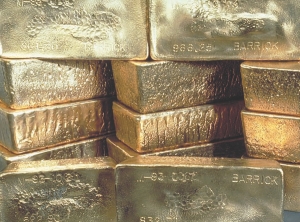DENVER, COLO. — One wore a black cowboy hat and the other, a white one. This being the Denver Gold Forum, it was only fitting that Martin Murenbeeld, chief economist at Dundee Wealth and arguing the bullish case for gold prices, would be the man in white.
But it was Paul Walker, chief executive of GFMS, and the man in black, who got things going at a luncheon debate in front of a crowded conference room at the Hyatt Regency in downtown Denver.
Walker built his case — unpopular as it was in this setting — around the concept of investment flow. He noted that it has taken vast amounts of such flow to get gold prices up to their lofty heights, and that new flow has to constantly be found if such prices are to go higher.
More worrisome for gold investors is Walker’s contention that even if the amount of flow remains constant, the price of gold will still fall because of increasing supply, which has largely been brought on stream thanks to higher prices.
While in the short term, he believes that investment demand is strong enough to support higher prices, he doesn’t believe it will be a few years out.
Tied to his argument is his contention that gold bugs have been incorrect in their belief that relative to other assets, gold is still under- invested.
“In fact,” says Walker, “gold has performed quite well as an asset class.”
The reason for the discrepancy between perception and reality, as Walker sees it, is that gold investors too often compare gold to bonds or equities in general. This is a mistake, however, because while gold is gold, a Greek bond is not the same thing as German bond, nor is a blue chip stock the same as a junior explorer’s stock.
Comparing gold investment to investment in bonds, therefore, is an apple to oranges comparison that makes gold look relatively under-invested, when in fact this is not the case, he argues.
So if gold is not under-invested and if it needs continuously increasing flows of capital to maintain prices, why does it keep rising?
Walker concedes that currently there is enough investor interest in the metal to sustain further price gains, but, he cautions, if something like interest rate hikes appear on the horizon, investors will get spooked and prices could fall back to the US$800-per-oz. range. It is only around that level that fabrication demand would come back on stream — it has currently waned because of high prices — and begin to sop up excess supply.
It was on this final point that Murenbeeld got hot.
He abruptly accused GFMS of being stuck in the past as it overestimates the role that the fabrication side (demand for gold by jewelry manufacturers) plays in modern day gold prices.
As Murenbeeld sees it, the fabrication market was a significant part of the pricing equation in the ’90s when central banks were selling gold and investment demand was low, but in the past decade gold prices have been driven by investment, with fabrication having a negligible impact on price.
The increased prominence of investment demand has, in part, come by way of the advent of the exchange- traded fund. Murenbeeld says that until ETFs came along, buying and holding gold was a complex and often costly endeavour that potential pushed investors away.
Happily for gold bugs, the coming of ETFs dove-tailed with economic conditions that have made gold one of the most sensible assets to buy.
While Murenbeeld believes that looser monetary policies in the developed world over the last two years were and are necessary to get the Western world out of a recession, the net effect of such actions has been a weakening U.S. dollar.
“Central banks are mandated to be the printers of money, so that’s just what they’ll do when the conditions call for it,” he says.
But while printing money may be necessary in recessionary times, the policy only accelerates a trend that has been ongoing for several centuries.
According to Murenbeeld, fiat currencies have done nothing but lose value since their advent a few hundred years ago, while gold has always remained a store of value.
That isn’t to say, however, that gold prices will continue their upward march uninterrupted.
Murenbeeld concedes that, as with all asset trends, there will be a countertrend within the metal’s secular bull run, but he believes that turn won’t come for a few years and that it will eventually be erased by renewed investor enthusiasm for the metal.
To further support his case, Murenbeeld points out that the countries that hold gold as part of the reserves are no longer in a selling mood (as they were in the 1990s), and on top of this, emerging countries are increasingly looking to add gold to their reserves.


Be the first to comment on "Bear vs. bull at Denver Forum"